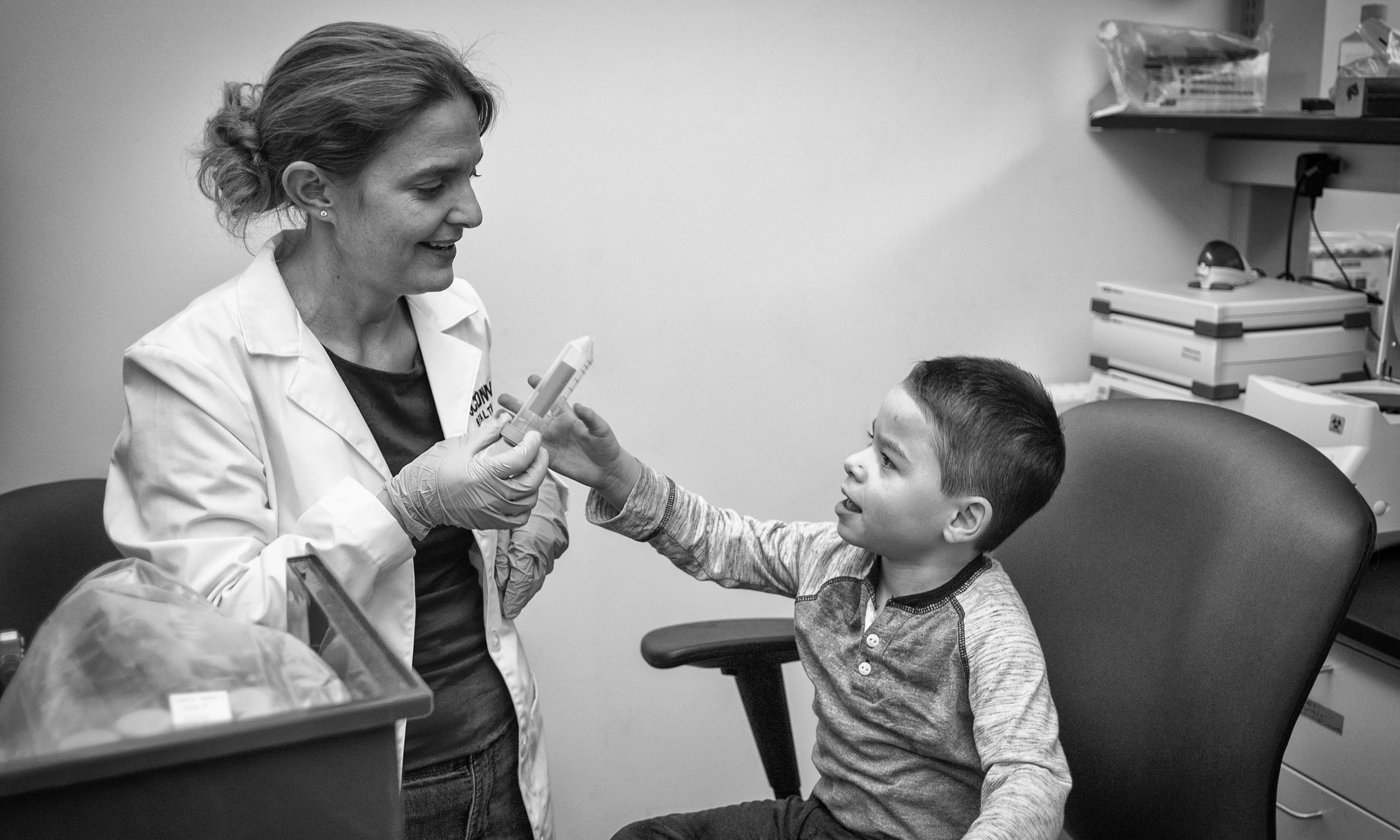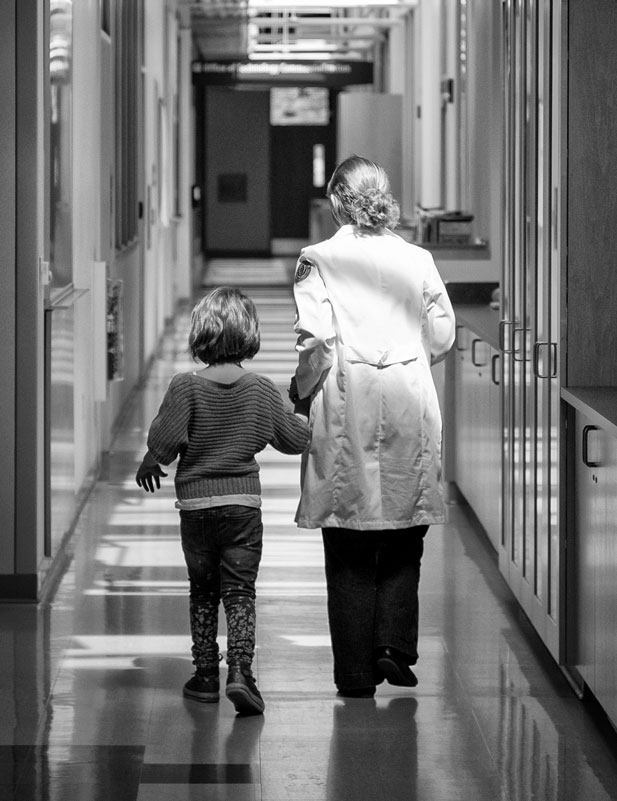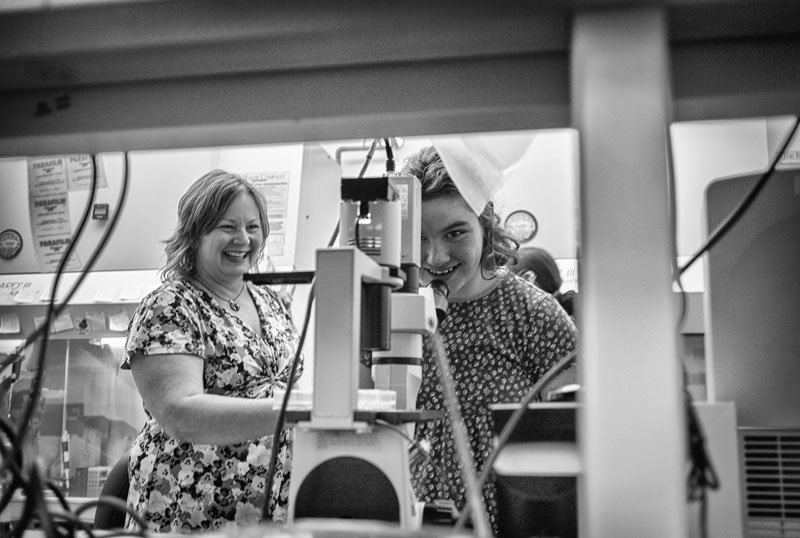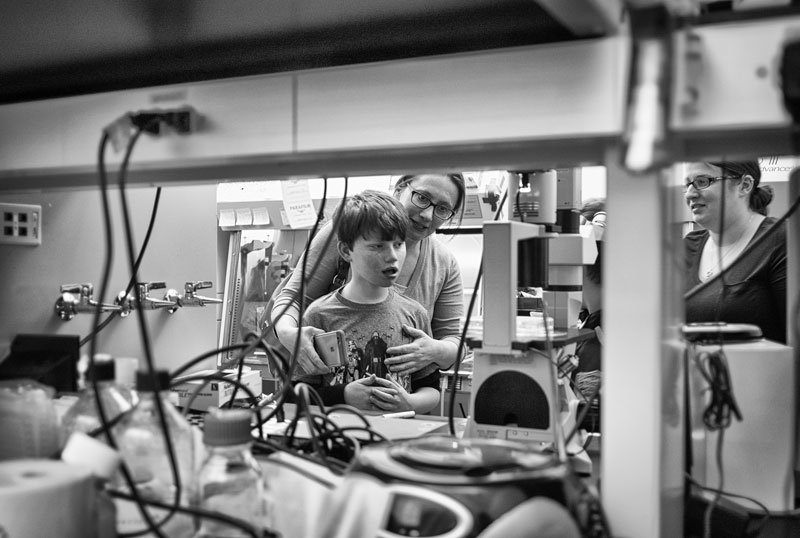AMONG ANGELS
Stormy Chamberlain is a new breed of scientist unafraid to let her research subjects have names and faces — and families.
AMONG ANGELS
Stormy Chamberlain is a new breed of scientist unafraid to let her research subjects have names and faces — and families.

STORMY CHAMBERLAIN AND JOEY MORETTI IN THE LAB
By Katharine Whittemore
Photos by Peter Morenus
Joey Moretti loves to open doors. And this one gives way to the Cell and Genome Sciences Building, a glassy hive of labs and offices in the UConn Health corridor in Farmington, Conn. It's the last day of March. The wind blows helixes of leaves into the sky. Joey, who is 4, is here because Stormy Chamberlain invited him, along with a dozen other children and their families, to tour the works.
And so begins three hours of cheerful pandemonium. Some kids tool around touching everything, their parents exerting mild but practiced vigilance. Others lean from their strollers. As Chamberlain bumps the group erratically forward, her blonde ponytail lifting as she kicks up speed, she points out various sights: centrifuges, pipettes, microscopes, trays of cell cultures. She and her four graduate student assistants also answer these parents' informed questions. Words cut through the commotion:Â neuron, deletion, imprinting, RNA.
Chamberlain is an assistant professor of genetics and genome sciences. And, it's fair to say, she's a big deal: The day before this tour, she was named one of the "nine best female scientists you should know" by the website Fiat Physica. She's a graduate of Princeton. She's worked at some of the top genetics labs in the country. She's won prestigious awards for both her teaching and her research. But this 40-year-old mother of two hardly stands on ceremony. Indeed, she had to scare up a white lab coat for the occasion, and when asked if she has any hobbies, she jokes they are (1) "running, then drinking beer" and (2) "yelling at my kids — and I'm getting better at it."
There's another reason Chamberlain is at home with today's tumult: she comes from a big ranching family in Wyoming, and has been on plenty of cattle drives. So she's perfectly fine when Joey, smiling broadly, adores doors. Click, thwack, go the metal lab doors. Bang, bang, BANG, goes the janitor's closet. "Opening and closing doors, that's a big accomplishment for Joey," explains his dad, Joe, who oversees his son's labors while also corralling two-year-old Luca, Joey's little brother.
Joe Moretti is VP of operations at The Edge Fitness Club, but these last few years he's become something of an amateur geneticist. As the doors whoosh and clang, he strains to hear Chamberlain describe her team's latest research. It concerns Angelman syndrome, the chromosomal abnormality Joey and all these kids share.
Harry Angelman was a British pediatrician who, in 1965, noticed that three similarly disabled children were admitted to his ward at the same time, "purely by chance," as he wrote decades later. Each had a jerky gait, a large mouth and widely spaced teeth, almost no speech, and excessive laughter. Angelman wrote a paper on the children, which fell into obscurity until the 1980s, when the disability began to be studied in earnest. Since then, scientists have learned that Angelman syndrome is a rare neurogenetic condition that occurs in 1 in 15,000 live births. It results from a problem with a single gene called UBE3A that lies on the 15th chromosome inherited from the mother.
Angelman syndrome causes severe cognitive delays, seizures, and impaired bodily coordination. Most of the children visiting today walk with a hitch. Some can't walk without assistance. Most speak fewer than 50 words. None is likely to ever live independently.
But this chromosomal malfunction, for reasons yet unknown, also produces a surprisingly sunny disposition. Angelman kids — often, understandably, called "angels"— smile and laugh a great deal. The Scottish poet Richard Price has a daughter with Angelman syndrome, and in his poem "Hand Held" he writes, "We are champions of grin."
Or as Joey's mother Tai puts it, "Joey makes you feel you have to be happy — because he is."
That's the unexpected thing, maybe — that happiness is the presiding emotion at the lab today. This doesn't discount the exhaustion the families feel over the challenges of raising disabled children. Nor the frustration the researchers feel, even if they're getting closer to understanding what causes Angelman — and how gene therapies may reduce its effects in the coming decade. It's just that the kids are so endearing. And the parents are so tolerant.
"These lab tours are such a great chance to connect with the other families and meet the researchers," says Bob Dell. "This really fosters team-building and a sense of community." Dell manages to eke out these full sentences while his son, 9-year-old Gabriel, enfolds him like an octopus. "He likes to use my ears as handles," Dell says, smiling. Over in the lunchroom, Katie DeLucia, age 13, in a blue flowered dress, is half teaching the recently viral "Whip Nae Nae" song to graduate student Judy Bloom. Twirling, stumbling, giggling ensues.
In between these dance sessions, Bloom presents her own area of research to the families. It focuses on how Angelman neurons "talk" to each other. Picture a neuron as sort of a mushroom with nubs on it, she says. There are fewer nubs on the Angelman neurons than on typical neurons. "My hypothesis is that those fewer nubs cause problems with communication," she explains. So she's creating mathematical models to figure out how, and how much, the neurons signal each other.
Down the hall, Chamberlain helps Joey climb onto her lab swivel chair so he can make the world spin.
I need this human connection," Chamberlain admits. "As scientists, we're trained to be really focused on the science"¦but"¦I think that the goal is to use our talents for good."

I need this human connection," Chamberlain admits. "As scientists, we're trained to be really focused on the science"¦but"¦I think that the goal is to use our talents for good."

BUCKING TRADITION
If you know the remarkable and devastating story behind the 2010 best-seller The Immortal Life of Henrietta Lacks by Rebecca Skloot, you know that the Lacks family never experienced a lab tour anything like this. Lacks was a poor African-American woman who had cervical cancer. Just before her death in 1951, she became an unwitting source of cells. Those "HeLa" cells were cultured by clinicians, found to thrive, and became the first immortal cell line for medical research. They were crucial to developing the polio vaccine, cloning, gene mapping, and more, and are still used in labs all over the world.
But, as Skloot reveals, the Lacks family was not informed about this, and was systematically, even hostilely, marginalized from the research practiced on the cells of their loved one.
Times are different now. But Lacks' story is one reason there remains tension, even distrust, between the world of research and the researched. If the days of the worst transgressions are over, the era of eugenics and uninformed consent, there's still a clinical depersonalization, a dearth of interchange. Today, most research subjects are a number, not a face. And those subjects rarely actually know the researchers — much less are Facebook friends with them, like today's guests and Chamberlain. Or have attended ad hoc Genetics 101 classes like the ones Chamberlain is giving here. Or strode beside each other at walkathons for the Angelman Syndrome Foundation.
Clearly, the research is personal for Chamberlain. "I need this human connection," she admits. "As scientists, we're trained to be really focused on the science and to prize that ahead of everything else. But I don't think so. I think that the goal is to use our talents for good. What is my intrinsic motivation? It's to ultimately help these families that I've gotten to know."
Leah Boice, who's here today with her 9-year-old daughter Emily, has spearheaded those ASF walkathons locally. As Emily pulls her close, Boice gets up to thank Chamberlain for all she does: "My friends involved in other causes are jealous of us because our researcher comes to our walks." This gets a laugh. Then Chamberlain adds her own thanks to all the families for their inspiration and support, giving a special nod to the Morettis' charity, the Fighting Angels Foundation, which recently awarded her research team a grant. She knows that funding for rare diseases is limited, and that staying close to the Angelman community can only help their cause and hers.
"Stormy totally hears us," says Jim Kubicza, a big, friendly man who's visiting with his son Cole; along with mom Jenn and brother Lincoln, they've dubbed their road race team, in which Jim pushes Cole in a stroller, "Team Cole Slaw." Cole's 6, and today presents a vision in red (his shirt), white (his fair hair), and blue (his sky-colored, past-its-prime nail polish). "She comes to all the events, and has a special connection with us," adds Kubicza. "Everyone in the Angelman community knows who Stormy is."
BREAKING THROUGH
To be clear, Chamberlain is not drawing a battery of blood, skin, or other cell samples from these families, so their situation is not exactly analogous to the Lacks family's. They hear — and ask — more about the research than clinically participate in it. Chamberlain's UConn team doesn't need many samples from them because they have devised a way to grow their own "induced pluripotent stem (iPS) cells." Chamberlain made the first iPS cells in Connecticut using Angelman syndrome fibroblasts, which reside in connective tissue that produces collagen and other fibers. These cells were derived from a family in Canada that has the UBE3A mutation — of the four known pathways of Angelman, it's the only hereditary one. (See "Four Genetic Pathways for Angelman Syndrome")
"What we're doing is we've taken an Angelman cell line and we've genetically corrected it," Chamberlain explains.
To do this, they use the CRISPR technique, a crisp acronym for a mouthful of a title: Clustered Regularly Interspaced Short Palindromic Repeat. CRISPR is actually a normally occurring bacterial process. Bacteria may incorporate foreign DNA and even, Pac-Man-style, scavenge damaged DNA from their environment. In other words, it's a genetic pair of scissors — and a game-changing technology.
"With CRISPR capability, we can find the specific neuronal dysfunction," says Chamberlain.
The most exciting work with these cell lines comes courtesy of Chamberlain's senior Ph.D. student, Jack Hsiao. Cole makes a beeline for Hsiao today, insisting on holding his hand and then swinging it with abandon. The Taiwanese-born scientist, whom Chamberlain admiringly calls "an expert question-asker," is probing something called the "antisense transcript." It's a single strand of RNA that silences the father's UBE3A gene. In Angelman syndrome, the mother's gene is missing UBE3A, but the father has a spare. With this silencing, though, that spare is taken out of play, too. The father's copy of UBE3A has been silenced by the antisense transcript. Hsiao helpfully conjures the metaphor of a train track here: Think of the antisense as one train on a track. The father's UBE3A is another train. They are barreling toward each other. For some reason, the antisense always wins, and bumps the UBE3A train off the track.
Hsiao has discovered a boundary element (he calls it a "stop sign") that's somehow been deactivated. If we could reinstall the stop sign, maybe the antisense train would stop before it derails the UBE3A train. He's found that the antisense is only made in neurons, so he deleted the stop sign in human iPS cells to find out how it works.
"It's just a novel regulatory element in the human genome," says Chamberlain. "And that's super interesting."
FOUR GENETIC PATHWAYS FOR ANGELMAN SYNDROME
Right now, we know of four genetic causes for Angelman syndrome that can be established by genetic testing. They explain about 85 percent of Angelman cases, which means some 15 percent of Angelman cases are due to unknown causes. Of the known causes, three — deletion, imprinting, and UPD — are spontaneous mutations, and are not hereditary.
(1) DELETION:Â The UBE3A gene is deleted on the person's maternal chromosome 15. This is the most common cause for Angelman. How many affected? 70 percent. A child on today's visit: Joey Moretti.
(2) UBE3A MUTATION:Â This takes place due to a mistake in the genetic code of the UBE3A gene on the maternal side. This mistake can occur anywhere on the gene, yet two particular regions (called Exon 9 and Exon 16) are more prone to mutations. The UBE3A mutation is hereditary and can account for multiple Angelman births in one family. How many affected? 5"“10 percent. Children on today's visit: Libby and Tyler Gregory.
(3) IMPRINTING:Â This happens when the mother's chromosome 15 acts like the father's chromosome 15, and is thereby silenced. How many affected? 3"“5 percent. A child on today's visit: Katie DeLucia.
(4) UNIPARENTAL DISOMY (UPD):Â Two (di) copies ofchromosome 15 come from one (uni) parent (in this case, the father), rather than one chromosome from each parent. Because the maternal egg has no chromosome 15, and thus no crucial maternal UBE3A gene, the sperm will often duplicate its own chromosome 15 so the baby will have the right number (two) of chromosomes. How many affected? 2"“3 percent. A child on today's visit: None.
"Sometime last year, I decided that I would be totally happy with my career if I could say that I contributed to one therapy for Angelman syndrome."

KATIE DELUCIA WITH MOM JILL

TYLER GREGORY WITH MOM JOANNA
EASTWARD HO
If you were wondering, Stormy is Chamberlain's real name, not a nickname. "It was a seventies thing," she says with a laugh, adding that she has cousins named Rainy, Reno, and Rebel. The name also trended from the 1968 radio hit "Stormy," by the Florida soft rock band The Classics IV. Born in 1975, she's the oldest of five, the daughter of cattle ranchers who have a 2,000-acre spread just outside Casper, Wyo.
"Ranchers have kids so that they have help, but I think my parents also like me," she jokes. But the work was no joke. "I'd get up at 4:30 a.m. and go out and milk a couple of cows by hand," Chamberlain recalls. "At night, we loaded the feed trucks, and did chores from five o'clock to eight o'clock, so I didn't start my homework until late. I know I will never again work as hard as I did growing up in Wyoming. So now, when I have a grant due, and I feel really stressed that there's a ton to do, I'm like, 'This is nothing.'"
Chamberlain notes that many scientists were raised on farms or ranches. She thinks a natural curiosity springs from living off the land and tending farm animals, which morphs into scientific inquiry. There's also a can-do attitude and a make-do knack for technology. "My first inclination is to fix things when they break," she says. In childhood, she drove a tractor to cut hay, and if the cutters on the swaths busted, she'd repair them in the field, armed with wrenches and bolts. These days, she'll get right in there and fix errant centrifuges in the Farmington facility.
In 7th grade, a teacher recognized her smarts and work ethic and suggested she go to a summer science camp at Iowa State. One summer in high school, she studied mouse genetics at the Jackson Laboratories in Bar Harbor, Maine. And then, college.
"It was a huge culture shock to go from a ranch in Wyoming to Princeton," she reflects. Chamberlain is a political conservative and a Baptist ("but the live-and-let-live Wyoming type," she stresses). "There were kids there who came from highly privileged backgrounds. It just didn't make any sense to me, and IÂ had a hard time adjusting."
On the positive side, she had the chance to study with Shirley Tilghman, a renowned molecular biologist who later became the president of the university. Chamberlain became enthralled by Tilghman's area of expertise, genomic imprinting, exploring how some genes are expressed only from the mother's or father's copy of chromosomes, rather than both. She graduated in 1997 with a BA in molecular biology and then did her graduate studies at the University of Florida College of Medicine. That's where she worked with Camilynn Brannan, a professor of molecular genetics and microbiology and another of Tilghman's protégés.
Her Gainesville stint imprinted itself on Chamberlain, judging from the orange-and-blue Gator signs and coffee mugs in her Farmington office. And during those years — she'd get her Ph.D. in Medical Science-Genetics in 2003 — her biggest project involved studying mice with Prader-Willi syndrome, which is a disorder closely related to Angelman. In Angelman, the affected genes are on the maternal copy of chromosome 15; in Prader-Willi, it's the paternal copy. One of the most galvanizing findings from her University of Florida research concerned how the antisense transcript negates the father's UBE3A gene in Prader-Willi — a relevant background for her current research at UConn.
She next headed to the big mouse-genetics labs at the University of North Carolina at Chapel Hill for postdoctoral work. It was at UNC that she met her future husband, Scott Oloff. Scott ended up in a series of jobs in New England, which is what eventually landed Stormy at UConn. The couple now has two children, Marshall, 3, and Josey, 5 ("She's my nod to Clint Eastwood," cracks Chamberlain, meaning the classic Western "The Outlaw Josey Wales").
When Chamberlain decided to complete her postdoctoral fellowship at UConn, she says, the stars aligned, because here she found Marc Lalande, professor and chairman of the Department of Genetics and Genome Sciences at the School of Medicine, who had a longstanding interest in Angelman and Prader-Willi.
Looking back on how she got here from here, there, and everywhere, Chamberlain turns to her faith: "I think God made me a scientist and gave me the curiosity and the talents to do this, and he has always provided the next opportunity to move forward in the field." And the big picture?
"Sometime last year, I decided that I would be totally happy with my career if I could say that I contributed to one therapy for Angelman syndrome."
"Joey makes you feel you have to be happy — because he is."
MOM TAI WATCHES AS CHAMBERLAIN LETS JOEY TRY ON LAB GLOVES
WRAPPING UP
Although the research is her prime priority, team motivation is the close second. Her motivational techniques involve fun (she and Hsiao have a standing my-hypothesis-is-better-than-yours bet, with the winner getting an order of chicken wings). "In science, there's so much failure," says Hsiao. "And it really helps to balance it with fun." She's also intentional about connecting personally to her team, whose members are quick to tell me how much they appreciate that. "She has exceptional people skills," says student Carissa Sirois. The others share a significant look, and then all chime in at once: "Not many scientists are like that."
"The interaction with the families makes me so motivated," adds Bloom. "It makes even the crappiest day in the lab worth it because, hey, I got to dance with Katie." Darcy Ahern agrees: "It makes my work feel much more important. Sometimes it's like, 'these are just cells in a dish.' But I won't forget these faces."
As the tour winds down, the parents absently wipe those lovely faces (Angelman kids are known to drool). Those faces that also carry a lot of energy and expression; the angels are pretty much all extroverts by nature and love the attention of fresh acquaintances. So energy, yes, but cacophony, no. You hear an occasional "Mama" but mostly, the young visitors gesture rather than vocalize, or press the screen icons on their PODD (Pragmatic Organisation Dynamic Display) devices. Joey pushes the icon for "microwave," for instance, and Tai laughs, guessing it's the closest symbol for what he really wants, the lab's vending machine, which (bonus) features a glass door.
No one seems to want to leave. They can't get enough of hearing about the research, but they're realists. "I'm not wishful that Cole will become one hundred percent typical," says Jim Kubicza. "It would help if he could walk unassisted, sure. But if gene therapies can't help him in his lifetime, I'm good with helping the next generation." Stormy riffs on what the future may bring. How she hopes newborn screening protocols will include testing for Angelman syndrome. How the research they do at UConn might be applied to other chromosomal conditions. How a clinical drug trial is a real possibility in the next 10 years.
A little way off, Joey admires his reflection in the glass door by the vending machine. Then he opens it, shuts it, opens it, shuts it. Stormy stays with her families and, taking his cue, talks about all the doors she hopes to open.
Hear Tai Moretti tell the story of how she and her husband found out — while on a family-and-friends vacation — that their son, Joey, had Angelman Syndrome.

Great researcher, great research. Keep up the good work!
“Love to see these steps taken by the whole team for this good work.There is very less association who work for human right and help others.I want to congratulate each and every member who works for the welfare of these children.
GREAT”